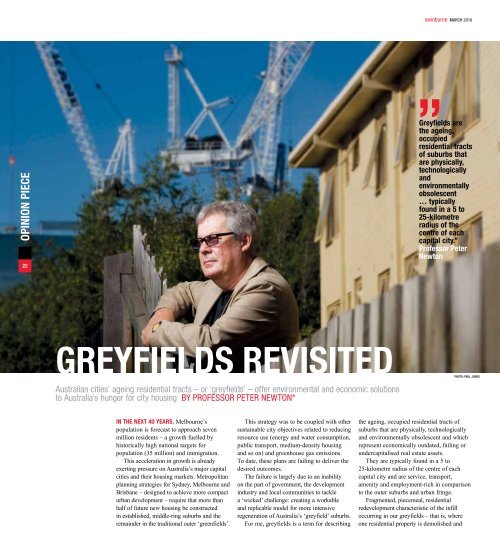March 2010 - Swinburne University of Technology
March 2010 - Swinburne University of Technology
March 2010 - Swinburne University of Technology
Create successful ePaper yourself
Turn your PDF publications into a flip-book with our unique Google optimized e-Paper software.
swinburne <strong>March</strong> <strong>2010</strong><br />
Opinion PieCE<br />
22<br />
,,<br />
Greyfields are<br />
the ageing,<br />
occupied<br />
residential tracts<br />
<strong>of</strong> suburbs that<br />
are physically,<br />
technologically<br />
and<br />
environmentally<br />
obsolescent<br />
… typically<br />
found in a 5 to<br />
25-kilometre<br />
radius <strong>of</strong> the<br />
centre <strong>of</strong> each<br />
capital city.”<br />
Pr<strong>of</strong>essor Peter<br />
Newton<br />
Greyfields revisited<br />
Australian cities’ ageing residential tracts – or ‘greyfields’ – <strong>of</strong>fer environmental and economic solutions<br />
to Australia’s hunger for city housing By Pr<strong>of</strong>essor Peter Newton*<br />
Photo: Paul Jones<br />
In the next 40 years, Melbourne’s<br />
population is forecast to approach seven<br />
million residents – a growth fuelled by<br />
historically high national targets for<br />
population (35 million) and immigration.<br />
This acceleration in growth is already<br />
exerting pressure on Australia’s major capital<br />
cities and their housing markets. Metropolitan<br />
planning strategies for Sydney, Melbourne and<br />
Brisbane – designed to achieve more compact<br />
urban development – require that more than<br />
half <strong>of</strong> future new housing be constructed<br />
in established, middle-ring suburbs and the<br />
remainder in the traditional outer ‘greenfields’.<br />
This strategy was to be coupled with other<br />
sustainable city objectives related to reducing<br />
resource use (energy and water consumption,<br />
public transport, medium-density housing<br />
and so on) and greenhouse gas emissions.<br />
To date, these plans are failing to deliver the<br />
desired outcomes.<br />
The failure is largely due to an inability<br />
on the part <strong>of</strong> government, the development<br />
industry and local communities to tackle<br />
a ‘wicked’ challenge: creating a workable<br />
and replicable model for more intensive<br />
regeneration <strong>of</strong> Australia’s ‘greyfield’ suburbs.<br />
For me, greyfields is a term for describing<br />
the ageing, occupied residential tracts <strong>of</strong><br />
suburbs that are physically, technologically<br />
and environmentally obsolescent and which<br />
represent economically outdated, failing or<br />
undercapitalised real estate assets.<br />
They are typically found in a 5 to<br />
25-kilometre radius <strong>of</strong> the centre <strong>of</strong> each<br />
capital city and are service, transport,<br />
amenity and employment-rich in comparison<br />
to the outer suburbs and urban fringe.<br />
Fragmented, piecemeal, residential<br />
redevelopment characteristic <strong>of</strong> the infill<br />
occurring in our greyfields – that is, where<br />
one residential property is demolished and
















